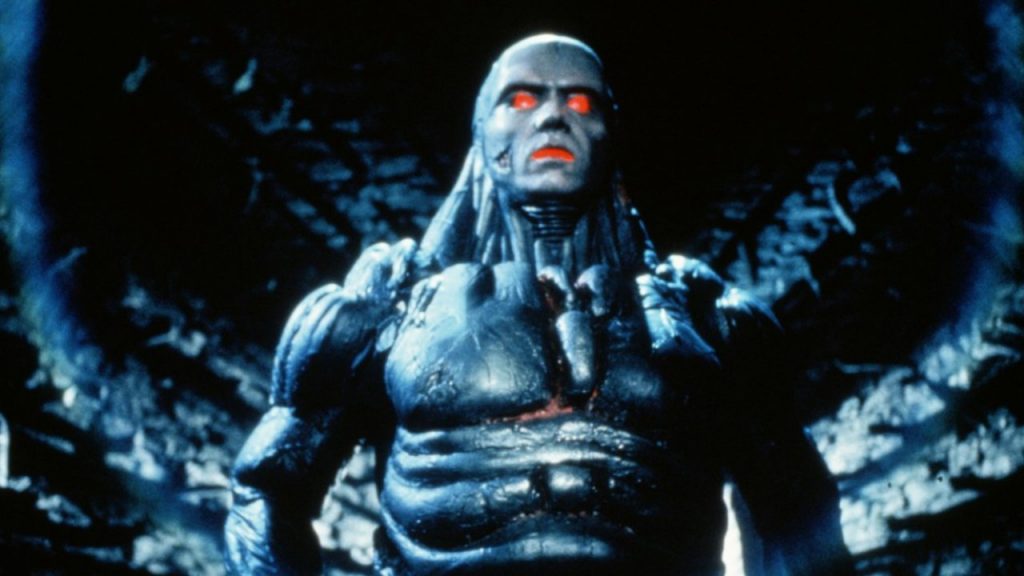Arriving at the onset of “spooky season,” the Criterion Channel’s ’80s Horror series offers a veritable goodie bag to choose from this October. Along with many of the genre’s heavy hitters – the ones who can go by their surnames, like Argento, Cronenberg, Hooper, Fulci, Henenlotter, Cohen, and Carpenter – the 30-film series carves out slots for directors who only dabbled in horror once or twice. One of those dabblers is Michael Mann, who was coming off the Chicago-set neo-noir Thief when he signed on to adapt F. Paul Wilson’s 1981 novel The Keep.
Far removed from the gritty, urban milieu of Thief, The Keep takes place in a tiny village in Romania’s Carpathian Alps in 1941, when Nazi Germany was at the height of its power and reach. That matters little to those with their boots on the ground, however, as embodied by Jürgen Prochnow’s weary Wehrmacht Captain Woermann, who is emphatically not a party member. The exact opposite is true of Gabriel Byrne’s zealous SS officer, Major Kaempffer, who arrives with his own troops when Woermann’s soldiers start getting picked off while they’re guarding a mountain pass. (In such a self-serious film, a line like “We found the rest of Steiner” is a welcome bit of comic relief.) What neither man realizes is this is not the work of the villagers or the partisans they’re suspected of harboring, but rather an ancient evil that has been imprisoned for centuries, waiting for someone foolish enough to release it.
Woermann and Kaempffer’s ideological clash isn’t the only one Mann highlights in his screenplay. There’s also the lively theological debate between Father Fonescu (Robert Prosky, returning from Thief), the local religious authority, and Dr. Theodore Cuza (Ian McKellen), a Jewish professor of medieval history Fonescu gets out of a concentration camp (along with Cuza’s daughter) by convincing Kaempffer he’s the only one who can translate a cryptic message found on the wall of the Keep where the Germans have been staying, despite the dire warnings not to. Then again, Woermann’s men were explicitly told not to touch the 108 nickel crosses lining its walls and within minutes of rolling their equipment in, one of them starts prying a cross loose. (That he’s the first to die is a given, and since most of the film’s casualties are German soldiers, this relieves the viewer of having to care about their fates.)
The third axis of conflict is more obscure, and likely suffered the most from Paramount’s post-production tampering. This doesn’t become truly evident until roughly an hour into the theatrical cut, when Scott Glenn’s mystical stranger Glaeken arrives in the village – after riding his motorcycle through multiple fairy-tale forests – and almost immediately beds Cuza’s daughter Eva (Alberta Watson). That he was awoken at the very moment the being in the Keep was unleashed casts them as two sides of the same coin, but Mann keeps the nature of Glaeken’s sinister counterpart ambiguous, waiting until the 45-minute mark (when it explodes a couple of Nazi heads and uses its powers to rejuvenate the frail Cuza) to give it physical form: an amorphous, smoke-enshrouded body with red, glowing eyes and mouth. By the time of its second encounter with the scholar, the being – named Molasar in the credits, although this name is never spoken in the film – has taken on the countenance of a golem, with visible veins and muscles, so naturally Cuza believes Molasar will be his instrument of revenge against Hitler and all the evil men who put him and his kind in concentration camps. Things have to get downright biblical, though, before he realizes the enemy of his enemy isn’t necessarily friendly.
With so many heady themes in play – war, the Holocaust, faith vs. reason, good vs. evil – it’s hardly surprising that The Keep got away from Mann. While it’s been widely reported that his original cut ran three and a half hours, it’s more likely the version screened for test audiences had a running time closer to two, as he was contractually obligated to deliver. What got lost during the pruning process was exacerbated by the studio’s hack-and-slash approach, which did serious damage to the film’s third act. Even in its hobbled form, though, what’s left of Mann’s The Keep (in particular. the impressive production design and Tangerine Dream’s moody score) is worth seeking out by his fans and horror junkies interested in a monster movie that’s a little off the beaten path.
Since its 1983 release, during which the film received a critical drubbing and failed to make back its $6 million budget, The Keep has remained an outlier in Mann’s filmography, one he intentionally talks little about. The film has also been MIA on home video in the US since its pan-and-scan VHS and laserdisc, which at least presented the full widescreen image. A 2020 Australian DVD marked The Keep’s debut in that format, and that year also saw the belated release of Tangerine Dream’s soundtrack in a boxed set of the band’s Virgin recordings. Since the rights to their music have long been considered one of the stumbling blocks preventing a DVD/Blu-ray release, Criterion streaming the film with the soundtrack intact is indeed cause for celebration. It would be inadvisable to hold one’s breath for a restored director’s cut, however, in spite of the extra material seen in various trailers and television prints. For 39 years, Mann’s adherents have been able to blame The Keep’s failure on studio interference. All things considered, it may be in his best interests to continue to let them.
“The Keep” is now streaming on the Criterion Channel, and is available to rent or purchase (in standard definition only) from the usual outlets.

